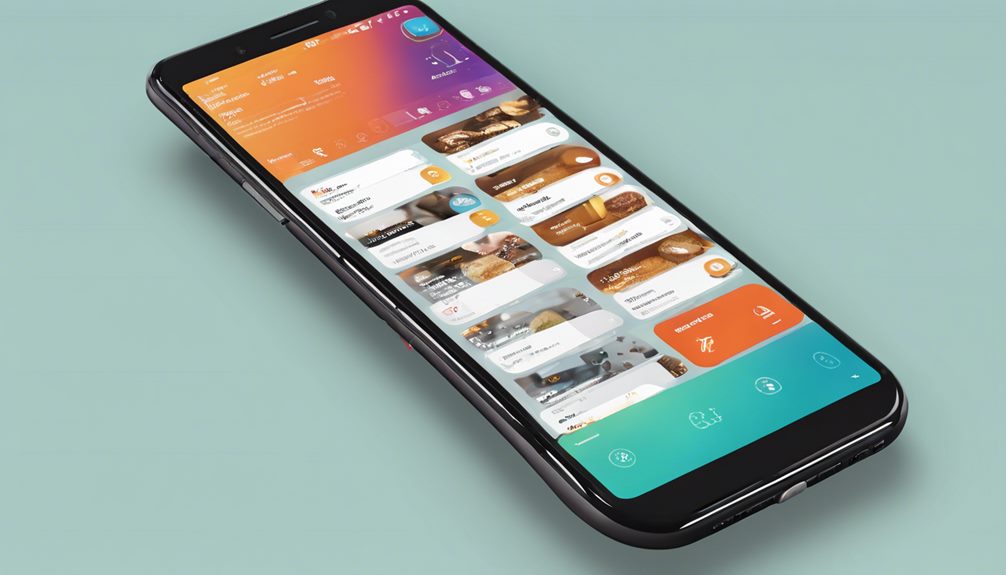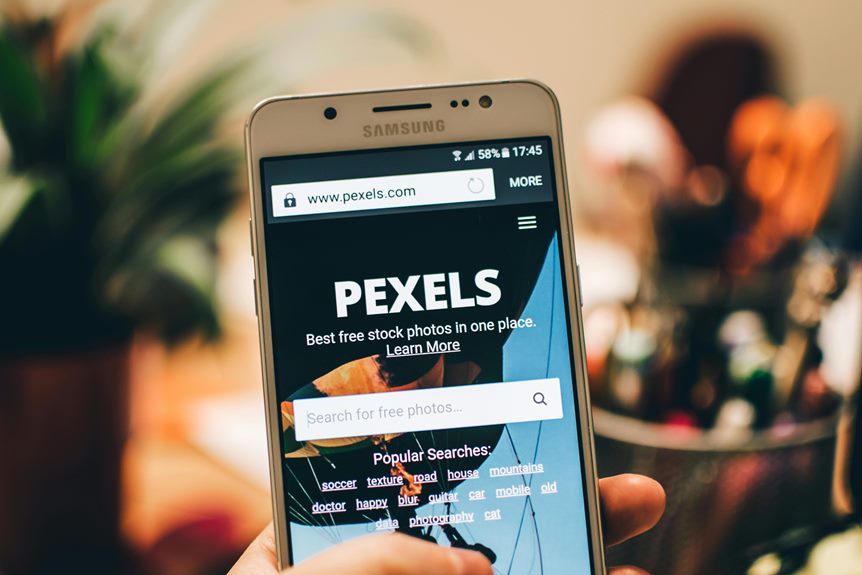When you're focusing on mobile SEO design, it's crucial to prioritize user experience and performance across various devices. You should consider implementing responsive design to provide seamless navigation and optimizing page load speed by compressing images and utilizing browser caching. Crafting mobile-friendly content layouts and leveraging Accelerated Mobile Pages (AMP) can also enhance loading times and search visibility. But have you thought about how intuitive navigation and readability can directly impact your conversion rates and search rankings? There's more to explore about how these elements intertwine to shape effective mobile SEO strategies.
Responsive Design Implementation
Responsive design implementation is essential for optimizing mobile SEO and improving user experience. By ensuring your website automatically adjusts to various screen sizes and orientations, you enhance accessibility and engagement. Data reveals that 58% of site visits come from mobile devices, highlighting the need for a seamless experience across all platforms.
Utilizing a mobile-first approach can significantly boost your SEO rankings, as Google prioritizes websites that are responsive and user-friendly.
Start by using fluid grids and flexible images. This approach allows your site's layout to adapt smoothly to different devices without losing its structure. Implement CSS media queries to apply specific styles tailored for mobile users. This technique ensures that your content remains readable and visually appealing, which is crucial for reducing bounce rates.
Consider incorporating touch-friendly navigation to cater to touchscreen users. Simplified menus and larger buttons enhance usability, making it easier for visitors to interact with your site.
Additionally, prioritize high-quality content that's concise and relevant, as search engines favor well-structured content. Remember, a well-executed responsive design not only improves user satisfaction but also strengthens your site's visibility in search engine results, driving more organic traffic.
Optimizing Page Load Speed
To boost your mobile SEO, start by minimizing image sizes, which can reduce load times by up to 80%.
You should also enable browser caching to store static resources locally, improving page speed for returning users by as much as 50%.
Minimize Image Sizes
Images often constitute the largest portion of a website's data load, so reducing their size is crucial for improving page load speed, especially on mobile devices. Mobile users expect fast-loading pages, and Google's algorithms reward optimized sites with better rankings. Compressing images is a key mobile SEO strategy. Use formats like JPEG 2000, WEBP, or AVIF, which offer high-quality visuals at reduced sizes. Data shows that such formats can cut image sizes by up to 50%, significantly boosting load times.
To optimize further, resize images to the exact dimensions needed on your site. Many websites mistakenly display images larger than required, wasting bandwidth.
Leverage responsive image techniques using HTML's "srcset" attribute, ensuring users only download images suitable for their device's resolution. This user-centric approach enhances mobile experience and SEO performance.
Don't overlook lazy loading, which defers off-screen image loading until users scroll to them. Studies reveal that lazy loading can increase page speed by 30%, improving user engagement and reducing bounce rates.
Enable Browser Caching
Efficient browser caching is vital for optimizing page load speed on mobile devices. By allowing browsers to store static files locally, you reduce load times significantly.
Studies show that a 1-second delay in mobile page load time can decrease conversion rates by up to 20%. So, you can't afford slow loading pages. Implementing browser caching means users won't need to download the same files every time they visit your site, leading to faster access and better user experience.
To enable browser caching, you should define cache expiration dates in your HTTP headers. This tells browsers how long they can store files.
Use tools like Google PageSpeed Insights to analyze your site's caching strategy. Recommendations often suggest setting cache durations for at least a week, especially for static assets like images, CSS, and JavaScript files.
Mobile-Friendly Navigation

A seamless mobile-friendly navigation system is crucial for keeping users engaged and enhancing their browsing experience. Studies show that 61% of users are unlikely to return to a mobile site if they've trouble navigating it.
Prioritize intuitive design by implementing clear menus, easily tappable buttons, and logical flow paths. A responsive navigation menu can significantly improve user experience and reduce bounce rates, positively impacting your mobile SEO performance.
Focus on creating a mobile-optimized menu structure. Use a hamburger menu to conserve screen space, allowing users to access the full menu only when needed. Make sure your menu options are concise, using keyword-rich labels that clearly describe page content. This not only helps users find what they're looking for but also aligns with search engine algorithms that favor user-friendly site designs.
Additionally, enable breadcrumbs to guide users through your site's hierarchy, making it easier for them to backtrack without frustration. Place primary navigation elements within thumb's reach to enhance usability further.
Moreover, ensure that your site's search functionality is prominent and efficient. Streamlining these elements won't only boost user satisfaction but also improve your mobile SEO rankings.
Content Layout and Readability
When it comes to mobile SEO, ensuring content layout and readability is paramount for user engagement and retention. Users seek information quickly, and a well-structured layout aids this process. Prioritize concise, scannable content with headings and bullet points to enhance readability. Keep your paragraphs short to prevent overwhelming users on smaller screens. Use font sizes and styles that are easy to read, and ensure sufficient contrast between text and background colors.
| Element | Best Practice | SEO Impact |
|---|---|---|
| Font Size | 16px or larger | Improves readability |
| Line Spacing | 1.5x line height | Enhances clarity |
| Content Length | 250-300 words per page | Increases engagement |
Another key aspect is ensuring your content aligns with user intent. Use keywords strategically, without stuffing, to maintain a natural flow. Organize content logically, guiding users seamlessly through your site. This not only aids users but also helps search engines index your pages effectively.
Image and Media Optimization

As you perfect your content layout and readability, don't overlook the importance of image and media optimization in mobile SEO. Optimizing images for mobile devices isn't just about compressing files. It impacts your page load speed, which is crucial since 53% of mobile users abandon sites that take longer than three seconds to load.
Use responsive images that adjust to different screen sizes. Consider WebP format, which reduces file size by up to 34% compared to JPEGs and PNGs, without sacrificing quality.
Alt tags are vital for accessibility and SEO. They help search engines understand image context, boosting your rankings. Use descriptive, keyword-rich alt text for each image.
Also, lazy loading can enhance your mobile site's performance. This technique defers off-screen images until the user scrolls to them, reducing initial load time.
Video content is engaging but can slow down your site. Use HTML5 for video embedding and ensure videos are compressed.
Implementing a content delivery network (CDN) can distribute media files efficiently, ensuring quick access for users worldwide. Prioritizing these strategies will enhance user experience, reduce bounce rates, and improve your search engine rankings, driving more traffic to your site.
Leveraging Accelerated Mobile Pages
Frequently, mobile web users demand fast-loading pages, and leveraging Accelerated Mobile Pages (AMP) can significantly improve your site's performance. AMP is designed to create lightweight web pages that load almost instantly, enhancing user experience and boosting engagement.
With mobile speed being a crucial ranking factor, AMP becomes a vital tool for optimizing your SEO strategy.
Here's how you can effectively use AMP:
- Boost Page Load Speed: AMP strips away unnecessary elements, making pages load up to 85% faster than standard mobile pages. This speed is crucial for reducing bounce rates and keeping users engaged.
- Improve Search Rankings: Google prioritizes fast-loading pages, which means AMP pages are often given a favorable position in mobile search results. This can lead to higher visibility and increased traffic.
- Enhance User Experience: Faster pages lead to better user experiences. AMP ensures content is accessible and loads seamlessly, which can increase user retention and lead to more conversions.
- Reduce Data Consumption: AMP pages consume less data, making them ideal for users with limited data plans. This can broaden your audience reach by appealing to data-conscious users.
Conclusion
You've explored the essential pillars of mobile SEO design, but what's the secret ingredient that ties it all together? It's the seamless blend of responsive design, lightning-fast load speeds, and engaging content. Imagine users effortlessly navigating your site, captivated by crisp images and compelling layouts. AMP boosts your visibility, but here's the kicker: prioritize user experience above all. The result? Higher conversion rates and improved search rankings. Are you ready to transform your mobile presence?


